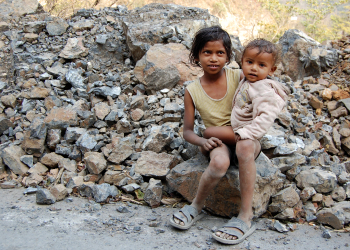A tear trickles down the faces of the poorest people as they feel helpless about their existence in the world’s poorest country. While passing by poor people living in literally, temporary box type shelters on the dusty streets of India, anyone will notice how the poorest people are struggling to try and survive. This article hopes to spread awareness about the extreme poverty in India and highlights what the Indian government hopes to do in the future to help India see the light at the end of the tunnel.
Poverty in India is of great concern. It is almost as if young children and adults are forced to walk on the road in their one and only set of clothes and weave their way in between the heavy moving traffic just to sell items to try and earn a little bit of money for their basic supply of food, that is, if they get any. The Diplomat recently claims, ‘among children under the age of five in South Asia, over 30% are underweight.’ This situation is unlike anything you will see in a developed nation such as the UK and the rest of the Western nations. Although India is a developing country, it is the poorest country in the world but only the second poorest country in South Asia. The Centre for Research and Globalisation and Global Research released an article in August 2014 which claimed, ‘640 million poor people live in India (40% of the world’s poor)’.
In a recent report in June 2014, The Economic Times claims, ‘India has asked the West to pledge additional and predictable funding to developing nations for eradication of poverty.’ The Environment Minister, Prakash Javadekar said: “The developed countries need to not only urgently fulfill their commitment to provide 0.7 per cent of GNI as ODA for developing countries but also pledge additional and predictable funding considering the ambition levels for post-2015 development agenda. Noting that eradication of poverty requires much more proactive and concerted action.”
The United Nations Millennium Development Goals (MDG) has already been set to lift India out of its poverty. However, even though India has failed to meet its 2015 development goals, as claimed by The Diplomat, recently in July 2014, poverty in India has fortunately not been forgotten. In fact, following the elections this year in India and especially since Narendra Modi is now the Prime Minister of India, he will be governing this country. In a recent article in The Economist from September 2014, Modi confides to the public, ‘by 2022 every Indian will have a house,’ he promises.
The Minority Affairs Minister, Najma Heptullah has a similar point of view. Heptullah said: “There was much work to be done but that the new government is committed to improving India’s record on basic developmental issues.” He promised, ‘when the fifteen-year review of the millennium development goals is undertaken in 2030, India will present a very different and upbeat picture.’
India is still facing extreme poverty. The poorest of people are deprived of having access to safe drinking water, housing, sanitation, nutrition and health and education. The former chair of the Indian-British parliamentary group, Labour MP, Keith Vaz commented on poverty in India. Vaz said: “There are still an estimated 360 million people surviving on less than 35 pence per day.” Today 35 pence might just be enough to buy a small packet of crisps or just a chocolate bar in the western countries.
Previous governments before the May 2014 elections in India, have continuously overlooked looking after the basic necessity of providing aid for the poorest people India. However, India has progressed in the past 20 years and many poorest people have been lifted from extreme poverty but there are many still needing help. Can poverty in India really come to an end?






















